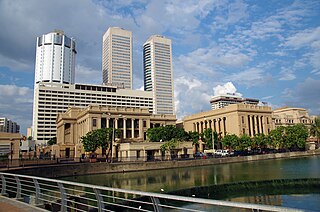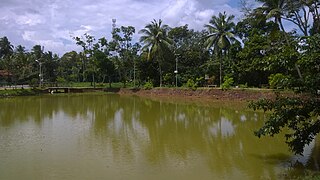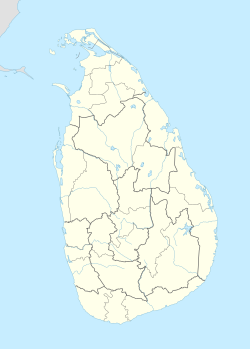
Colombo is the executive and judicial capital and largest city of Sri Lanka by population. According to the Brookings Institution, the Colombo metropolitan area has a population of 5.6 million, and 752,993 in the Municipality. It is the financial centre of the island and a tourist destination. It is located on the west coast of the island and adjacent to the Greater Colombo area which includes Sri Jayawardenepura Kotte, the legislative capital of Sri Lanka, and Dehiwala-Mount Lavinia. Colombo is often referred to as the capital since Sri Jayawardenepura Kotte is itself within the urban/suburban area of Colombo. It is also the administrative capital of the Western Province and the district capital of Colombo District. Colombo is a busy and vibrant city with a mixture of modern life, colonial buildings and monuments.

The Western Province is one of the nine provinces of Sri Lanka, the first level administrative division of the country. The provinces have existed since the 19th century but did not have any legal status until 1987 when the 13th Amendment to the Constitution of Sri Lanka established provincial councils. Western Province is the most densely populated province in the country and is home to the legislative capital Sri Jayawardenepura Kotte as well as to Colombo, the nation's administrative and business center.

St. Peter's College is a Roman Catholic boys-only primary to secondary (inclusive) school in the Bambalapitiya zone of Colombo, Sri Lanka, founded in 1922.

The Arya Chakravarti dynasty were kings of the Jaffna Kingdom in Sri Lanka. The earliest Sri Lankan sources, between 1277 and 1283, mention a military leader of this name as a minister in the services of the Pandyan Empire; he raided the western Sri Lankan coast and took the politically significant relic of the Buddha's tooth from the Sinhalese capital city of Yapahuwa. Political and military leaders of the same family name left a number of inscriptions in the modern-day Tamil Nadu state, with dates ranging from 1272 to 1305, during the late Pandyan Empire. According to contemporary native literature, such as Cekaracecekaramalai, the family also claimed lineage from the Tamil Brahmins of the prominent Hindu pilgrimage temple of Rameswaram in the modern Ramanathapuram District of India. They ruled the Jaffna kingdom from the 13th until the 17th century, when the last of the dynasty, Cankili II, was ousted by the Portuguese.

Karava is a Sinhalese speaking ethnic group of Sri Lanka, whose ancestors migrated throughout history from the Coromandel coast, claiming lineage to the Kaurava royalty of the old Kingdom of Kuru in Northern India. The Tamil equivalent is Karaiyar. Both groups are also known as the Kurukula.

The Kingdom of Kandy was a monarchy on the island of Sri Lanka, located in the central and eastern portion of the island. It was founded in the late 15th century and endured until the early 19th century.
Kalutara or Kalutota is a major city in Kalutara District, Western Province, Sri Lanka. It is also the administrative capital of Kalutara District. It is located approximately 43 km (27 mi) south of the capital Colombo. The city holds a unique position for one of the four major rivers in Sri Lanka, the Kalu Ganga, which joins the sea at the centre of the city. Kaluthara is known for making rope, baskets, and other articles from the fibre of the coconut palm. The area also produces the Mangosteens, a fruit introduced from Malaysia in the 19th century.

The Kingdom of Sitawaka was a kingdom located in south-central Sri Lanka. It emerged from the division of the Kingdom of Kotte following the Spoiling of Vijayabahu in 1521. Over the course of the next seventy years it came to dominate much of the island. Sitawaka also offered fierce resistance to the Portuguese, who had arrived on the island in 1505. Despite its military successes, Sitawaka remained unstable, having to contend with repeated uprisings in its restive Kandyan territories, as well as a wide-ranging and often devastating conflict with the Portuguese. Sitawaka disintegrated soon after the death of its last king Rajasimha I in 1593.

The Kingdom of Kotte, named after its capital, Kotte, was a Sinhalese kingdom that flourished in Sri Lanka during the 15th century.

Sri Dalada Maligawa, commonly known in English as the Temple of the Sacred Tooth Relic, is a Buddhist temple in Kandy, Sri Lanka. It is located in the Royal Palace Complex of the former Kingdom of Kandy, which houses the relic of the tooth of the Buddha. Since ancient times, the relic has played an important role in local politics because it is believed that whoever holds the relic holds the governance of the country. The relic was historically held by Sinhalese kings. The temple of the tooth is a World Heritage Site mainly due to the temple and the relic.

The National Museum of Kandy in Kandy, Sri Lanka is located next to the Temple of the Tooth in part of the former Royal Palace of Kandy. The primary exhibits are housed in the Palle Vahala building, which was the former home of the King's harem. A secondary exhibition is located in the main palace building. The museum is maintained by the Department of National Museums.
Vijayabahu VI was the son of Vira Parakrama Bahu VIII, who was an adopted child of Parakrama Bahu VI who founded the Kingdom of Kotte. He was born in c. 1445 and grew up with his brothers Sri Rajasinghe, Dharma Parakramabahu IX, and Raigam Bandara. He also had a sister who was married to Manamperi Arachchi.

St. Peter's College, Gampaha is a boys and girls primary to secondary (inclusive) and was a branch school of St Peter's College, Colombo. It is located in the Udugampola zone of Minuwangoda, Sri Lanka, and was founded on 2 February 1993. Even though the school is located in Gampaha district, St. Peter's College, Gampaha belongs to the Minuwangoda educational Zone.

Henarathgoda Botanical Garden, also known as Gampaha Botanical Garden, is one of the six botanical gardens in Sri Lanka. The botanical garden is situated on the Gampaha-Minuwangoda main road, approximately 450 m (1,480 ft) away from Gampaha railway station. It is about 29 km (18 mi) from Sri Lanka's commercial capital of Colombo.
Dewalapola is a small rural area in Minuwangoda Divisional Secretariate of Gampaha District, Western Province, Sri Lanka. It is situated on the 245/1 Nittambuwa - Katunayake / Airport bus route between Veyangoda and Minuwangoda.

Asgiriya Raja Maha Vihara is an ancient Cave temple situated in Gampaha District, Sri Lanka. The temple is located on top of a hillock on the Gampaha - Minuwangoda road and approximately 2 km (1.2 mi) away from Gampaha town. The temple has been formally recognised by the Government as an archaeological site in Sri Lanka. The designation was declared on 22 November 2002 under the government Gazette number 1264.

Pathaha Pokuna is an ancient bathing tank or pool situated in Udugampola, Sri Lanka. It is located approximately 0.45 km (0.28 mi) from Udugampola Roundabout and close to the historic temple Uththararama Purana Vihara. The pond has been formally recognised by the Government as an archaeological protected monument in Sri Lanka. The designation was declared on 8 July 2005 under the government Gazette number 1401.

Uththararama Purana Vihara is a historic Buddhist temple situated at Udugampola in the Western province, Sri Lanka. The temple is located on Udugampola – Weediyawatta junction road approximately 0.5 km (0.31 mi) away from the Udugampola Roundabout. The temple has been formally recognised by the Government as an archaeological site in Sri Lanka. The designation was declared on 7 July 2005 under the government Gazette number 1401.
Sakalakala Wallabha, was the viceroy or provincial king of the sub kingdom of Udugampola in the Kotte Kingdom during the sixteenth century. He was the son of King Veera Parakramabahu VIII of Kotte and his chief queen's sister. His brother, Thaniya-Vallabha, was the viceroy of Katupiti Madampe. He had four step brothers, Dharma Parakramabahu, Vijayaratne, Rajasingha and Raigam Bandara. The Rajaveliya recounts how together with his brother, he defeated a Muslim invader, who terrorised the area named 'Kadirayana' and restored peace.















